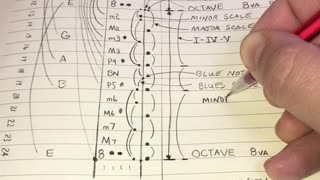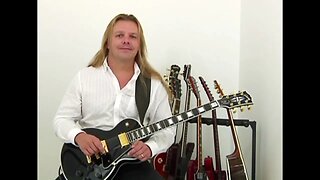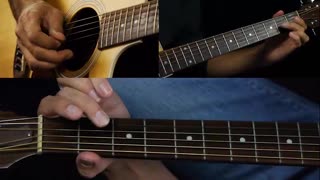Blues Rhythm Guitar Lessons for Beginners [12 Bar A Shuffle]
This Blues Rhythm Guitar Lessons for Beginners video by Paluzzi Guitar will show how to play a 12 Bar A shuffle.
Lesson Plan with guitar tab:
https://12a8507c-516b-2ae5-5b6d-45935a0049c2.filesusr.com/ugd/6781a9_9ddbc16e2a7243e085e86577153cd567.pdf
Blues Rhythm Guitar Lessons for Beginners [12 Bar A Shuffle]
0:00 Lesson Preview
1:00 Lesson Intro
1:15 'A' Shuffle Rhythm
2:30 Bars 1-4
3:03 Bars 5-8
3:56 Bars 1-8 (slow review)
4:42 Bars 9-12
6:44 Bars 9-12 (slow review)
7:15 Verse 1 (Bars 1-12 slow review)
8:24 Verse 2 Ending
9:47 Lesson Review
Blues Rhythm Guitar Lessons for Beginners
Most Blues songs are based from twelve-bar rhythm progressions, and learning how to play a 12 bar shuffle rhythm is essential for any beginner learning how to play Blues guitar. A 12-bar Blues shuffle rhythm involves strumming two adjacent strings, with the lower string providing a steady bass line while the higher string is periodically ‘tapped’ to a higher fret. This blues guitar lessons for beginners video will show how to play an easy shuffle rhythm with a 21-bar progression in the Key of 'A'.
How to Play Easy Blues Shuffle Rhythm on Guitar
A 12-Bar Blues shuffle rhythm progression consists of twelve sections or bars. Each bar in this Blues shuffle consists of eight beats (‘1-2-3-4-1-2-3-4'), which equates to two ‘taps’ (third finger to fourth fret) each bar.
How to Play Blues Shuffle Rhythm for Beginners
The letter name of each Blues shuffle rhythm is determined by its bass note (‘A’ = open fifth string). The first four bars in this 12-bar Blues rhythm progression are in ‘A’, consisting of 32 total beats or eight total ‘taps’ of the third finger.
In this 12-Bar Blues progression, Bar 5 shifts to a ‘D’ Blues rhythm shuffle. Focus on clarity by strumming just the third and fourth strings. (Some may prefer to use the left hand thumb to mute the sixth string when playing the ‘D’ Blues shuffle rhythm). Bars 7-8 of this 12-bar Blues rhythm progression return back to the ‘A’ Blues shuffle. Try playing Bars 1-8 together before moving on to Bars 9-12 of this 12-bar Blues progression lesson for beginners.
How to Play 12 Bar Shuffle Blues Guitar Lesson for Beginners
Bar 9 of this 12-bar blues shuffle lesson features a switch to an ‘E’ shuffle played for just one bar (two ‘taps’). Focus on clarity by playing just two strings for each bar, sounding the proper bass notes clearly for each shuffle.
How to Play a Blues Turnaround Guitar Lesson for Beginners
A turnaround is a standard technique used in 12-bar Blues rhythm progressions that creates tension at the end of one verse in order to ‘lead-in’ to another verse. When combining Bars 11-12 of Verse 1, maintain a steady tempo by following the suggested ‘count’ shown in the Tab section below.
12 Bar Blues Shuffle Rhythm for Beginners
At the end of this 12-bar Blues shuffle progression, which is the twelfth bar of Verse 2, substitute the Ending in place of the turnaround used in Verse 1. A suggested count for Bars 11-12 of Verse 2 is shown below the Tab, with the x’s representing the silent or muted third and fourth beats of the bar. Note how both the Turnaround and Ending sections of this 12-bar Blues shuffle rhythm progression each begin with a solid ‘1 - 2' count of the ‘A’ shuffle. Getting all five strings of the ‘A7' chord played to end this 12-bar Blues shuffle rhythm progression to ring clearly may initially be a challenge.
Blues Guitar Lessons for Beginners Playlist
https://www.youtube.com/watch?v=OVNcyOJHg_0&list=PLOKVJibwUTbr_Fq9kCp3mRfkhsP0f5jvf
Paluzzi Guitar
The objective of the Paluzzi Guitar video series is to help establish a foundation of guitar fundamentals by applying various playing techniques (rhythm, fingerstyle, and soloing) to various styles of music. The more playing styles and techniques a guitarist can learn, the more diverse and self-sufficient a guitarist will become. A self-sufficient guitarist can then teach themselves, communicate with other musicians, and even write their own music once a solid foundation of fundamentals is established.
The Creative Guitarist Method Series was written and designed by Kevin J. Paluzzi of Paluzzi Guitar Instruction in San Diego, CA. For more information on private lessons and books, go to:
There really isn’t any one particular playing style or technique required in order to classify someone as a guitarist. For example, Andres Segovia, the Beatles, and Carlos Santana are all considered legendary performing guitarists, but each has his own particular style or technique (fingerstyle, strumming, and soloing) for playing. The Paluzzi Guitar series of books and videos are designed with a ‘pick and choose’ topic format (songwriting, soloing, etc.) so that once the Guitar Basics are completed, the guitarist can decide to focus on whatever topic they wish to study.
-
![Blues Guitar Rhythm Lesson for Beginners [How to Play 12 Bar Shuffle]](https://hugh.cdn.rumble.cloud/s/s8/1/O/e/I/m/OeIme.0kob-small-Blues-Rhythm-Guitar-Lessons.jpg) 23:40
23:40
PaluzziGuitar
2 years agoBlues Guitar Rhythm Lesson for Beginners [How to Play 12 Bar Shuffle]
538 -
![Blues Rhythm Guitar Lessons for Beginners [12 Bar Shuffle In Any Key]](https://hugh.cdn.rumble.cloud/s/s8/1/A/M/g/K/AMgKe.0kob-small-Blues-Rhythm-Guitar-Lessons.jpg) 31:12
31:12
PaluzziGuitar
1 year agoBlues Rhythm Guitar Lessons for Beginners [12 Bar Shuffle In Any Key]
272 -
 9:54
9:54
Brian Kloby Guitar
10 months ago12 Bar Blues Rhythm Guitar Lesson, Play Electric Blues That Kicks - Brian Kloby Guitar
1.34K -
 14:12
14:12
Brian Kloby Guitar
11 months ago12 Bar Blues Guitar Lesson, Turnarounds That Rock - Brian Kloby Guitar
514 -
 8:02
8:02
Beginner Guitar
3 years agoLearn to count - Frets on a guitar fretboard - Beginning Guitar
270 -
 9:31
9:31
John Vedoe - The Versatile Guitarist
8 months ago $0.01 earnedGuitar Strum Pattern Techniques - Guitar Lesson + tutorial for beginners
55 -
 8:09
8:09
MarkoCoconut
1 year ago $0.02 earnedBLUES GUITAR full course PART 4
3292 -
 19:29
19:29
John Vedoe - The Versatile Guitarist
4 months ago $0.03 earnedTrouble playing BARRE CHORDS? - 5 EASY Strategies to play bar chords - Beginner Guitar Lesson
4592 -
 15:22
15:22
John Vedoe - The Versatile Guitarist
8 months ago $0.09 earnedHow to play NIGHT MOVES by Bob Seger. Guitar Lesson
252 -
 20:04
20:04
Center Stage Guitar Academy
3 years ago $0.13 earnedSolo Acoustic Blues - Guitar Lesson
617